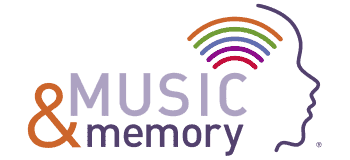
As the afternoons grew longer, Forrest would become agitated. He’d tell his son, Steve, in no uncertain terms, to bring him his car—despite the fact that Forrest had Alzheimer’s and could no longer drive. But listening to Elvis and other personal music favorites would enable him to calm down.
“The music would just mellow him out,” recalls Steve of his father’s experience with Music & Memory at Morning Pointe Assisted Living in Columbia, Tenn. “They could use music instead of his anti-anxiety medications. It all depended on the timing. He would sundown about the same time every day. If they put music on around 4:30 or 5:00, he’d calm down, tap his foot and sing.”
The same was true for Ed, a resident at Louisiana’s Morgan City Health Care Center, who would relax and cease being combative when he listened to his musical favorites. “He didn’t like to be surprised. I think that was the main thing,” says his wife of 56 years, Madelyn. “If the aides would walk in and go to change him, he would grab their arms and hold them real tight. Someone would have to pry his fingers off. He was a gentle giant all his life, but he would do it to me, too. It was the sickness.”
A big man, Ed suffered from dementia brought on by Parkinson’s. But listening to Cajun or Country Western tunes would make all the difference in his moods. “If they would put his earphones on, he’d quiet down and go along with almost anything they wanted,” recalls Madelyn. She adds that, as a result, Ed’s personal music playlist helped his aides to stay safer, too.
Research Supports Non-drug Approaches to Dementia Patients’ Common Symptoms
Forrest and Ed’s experiences with Music & Memory’s personal music program underscore the potential for non-drug interventions to ease dementia-related agitation and aggression. Indeed, in 2015, researchers from the University of Michigan Medical School and Johns Hopkins University concluded, after reviewing two decades’ worth of studies about overuse of psychotropic medications for people with dementia, that “non-drug approaches should be the first choice for treating dementia patients’ common symptoms, such as irritability, agitation, depression, anxiety, sleep problems, aggression, apathy and delusions.”
Study co-author Dr. Helen Kales described overuse of antipsychotics this way: “For many behaviors, it’s kind of like killing a fly with a cannon.”
“The Program Works”
Steve initially doubted the effectiveness of Music & Memory’s personal music program. After watching Alive Inside: The Story of Music & Memory, he was cynical. “I thought they just cut out all the bad stuff so it would be good for marketing. No way the music’s impact could be that instantaneous,” he says. “Until I did it with Dad. The program works.”
The head of a local insurance agency for many years, Forrest was the kind of man who “never met a stranger.” Steve adds, “Even with dementia, he’d try to sell you insurance. He’d be going into the hospital and say when we get done here we’re going to talk about insurance.” Watching his father change from such an outgoing individual who loved people to become angry and agitated when he sundowned was difficult, to say the least.
With his music—Forrest’s all-time favorite was Achy Breaky Heart—he would be more like his old self. “He’d smile more, he was happy,” says Steve. “He was always jovial. You could tell when he was having a bad day. The music would just lighten him up.” Diagnosed with aggressive liver cancer in August of 2017, Forrest died the following February. “Even in his last few weeks, when he wasn’t eating much, he still had the music playing,” says Steve. “He wasn’t as responsive, but I could tell he was loving it because he wasn’t as restless.”
“I Just Want Others to Benefit, as We Did”

For Madelyn, her husband’s personal playlist markedly improved his quality of life after he had become a flight risk at Morgan City. When first admitted last December, Ed would sit in his wheelchair by the doorway and wait until someone opened the door wide enough to wheel through. “The last time, they found him in the middle of the street, with traffic stopped on both sides,” she says. As a safety precaution, staff placed a brace around Ed’s leg to keep him from rolling his chair, as well as an alarm that would trigger if he came near the door. In turn, Ed became more withdrawn—and combative.
But when he listened to the Cajun music he grew up with, performed by artists like Iry Le Jeune, and Country Western hits by George Jones, Ed’s distress eased. A former welding inspector who ran crews on oilrigs off Louisiana’s Gulf Coast, he had been a man who made friends easily. Madelyn describes him as “always so compliant,” agreeable, willing to accept his limitations as his disease progressed—until he felt confined at the nursing home. Toward the end of his life, the music would also help her to feed him, whereas when agitated, he would turn his back.
Ed died in September. At the wake, Madelyn told her sister that his mouth didn’t look quite right. “That’s because he’s always smiling and laughing,” her sister said. Madelyn laughed and agreed. “He loved people, loved to talk, would walk up to you and introduce himself,” she says. “Music & Memory is a marvelous program. It helped my husband a lot, and me, too. I just want others to benefit, as we did.”
